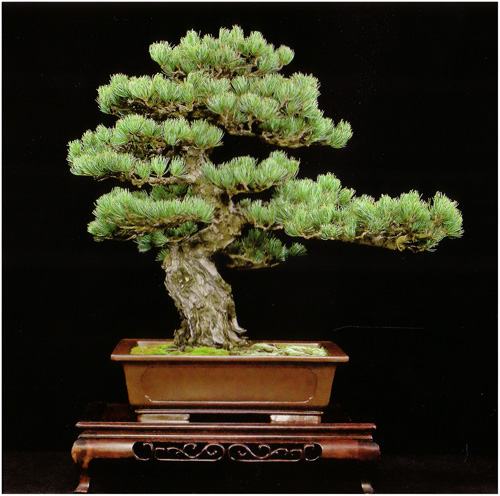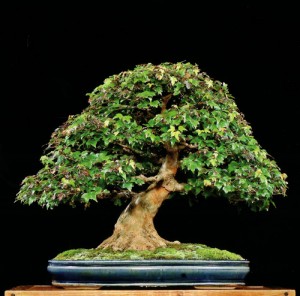
A pretty impressive bonsai with a modified S shape. It’s a Miyajima Japanese-Five Needle Pine (also called Japanese white pine – Pinus parviflora ‘Miyajima’) that was field grown for several years. The artist/owner is Ken Buell. The photo is from the 1st U. S. National Bonsai Exhibition Album.
Here’s the text of an email I received from Eric Killian…
I think bonsai bark has a lot of potential, but I’d love to see more on field growing. I have about 30-40 trees in the ground now but ground growing is completely new to me. Should I be giving trucks shape now? Possibly exaggerating it so in later years it will look like a nice flowing curve? I want to add character at a young age while avoiding the “S” trees that are mass produced.
… and here’s my original answer:
I understand your desire to see more on field growing and there will be more, but we are trying to cover a wide range of bonsai practice and appreciation, and field growing is just one piece.
It is good to start shaping trunks early while they are flexible. I sometimes use branch benders and sometimes wire (sometimes both). With wire you need to be careful; trunks grow fast in the ground.
S shaped curves:
As you can see from the two photos in this post, S shaped curves can be very pleasing. Still, there’s no doubt that they can also be overused, especially with commercial bonsai.
Exaggerating curves:
Yes. Exaggerate the curves. They will soften as trunks thicken.

Another example of an S shaped curved, albeit, a very soft one. It started as a stump (I imagine from a field) that was then container grown for twenty years. Like the pine above, it’s from the 1st U. S. National Bonsai Exhibition (it won the Yoshi Bonsai Tool Award for the Finest Deciduous Bonsai). The artist/owner is Martin Schmalenberg. The pot is by Nick Lenz. We like this tree so much that this is the second time we’ve featured it in Bonsai Bark.
Another very effective way of creating movement as well as taper in trees growing in the ground is to let them grow strongly for a few years, then cut the tree down to a few inches tall: Make the cut at an angle (which creates the first outside “bend” of the “S” shape).
Allow one shoot to continue growing at the top of the cut, and encourage the new shoot to continue the line created by the trunk chop. This will give movement and taper. Look at the trident maple; you can tell where the trunk was chopped if you visualize the tree growing straight up from the nebari instead of making the first curve to the right. The back (or back-left) side of the tree likely has a healed-over scar where it was cut from upper-right to lower-left, creating the outside curve of the first bend.
The resulting growth (the one shoot that was kept)is what continues the movement to the right. Do this as many times as you want bends, creating one section of trunk at a time. The upside is that the look can be much more natural, and you don’t slow down or scar the growth of the tree by wiring.
Regards,
Brian
Are steep, angular cuts really the best way to reduce the height of a trunk and induce “movement?” It just seems that making such a cut leaves a large wound for the tree to close and may look unnatural. I learned from a very well known bonsai artist and teacher a while back that it is best for a tree to cut as close to perpendicular to the angle of the trunk as possible; the tree will close the wound in a manner that appears very natural with time. Given my rudimentary knowledge of bonsai I could be very wrong here. Does anyone have any advice on this topic?
I’ve seen it done both ways. I think the slanted cuts leave bigger scars, but can create more radical taper. Most of the trees I’ve seen from China have slanted cuts. Brent Walston of Evergreen Gardenworks likes the perpendicular cuts, as do many Western bonsai enthusiasts. Brent has written a very informative article on trunk development that you might want to check out. http://www.evergreengardenworks.com/trunks.htm